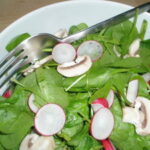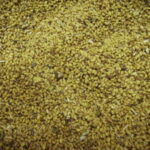It’s common knowledge that tiny vegetable and grain sprouts are packed with vitamins and nutrition, as well as a crunchy, nutty taste that goes great in salads and on sandwiches. About ¼ cup of grain or bean seed like alfalfa, peas, green beans, soy beans or radishes, expands to about a about a pint of protein-rich sprouts. What many people don’t know is how easy it is to sprout your own seeds at home. Using seeds you purchase for a minimal amount of money, you can have fresh, abundant sprouts available anytime you’d like.
You’ll need a one quart jar with a lid – a canning jar with a ring works really well, but you can reuse a pickle or jelly jar too, with some adjustments to the lid. You’ll also need a square piece of cheesecloth, nylon mesh (like from a clean panty hose or stocking, or thin, cotton linen – big enough to fit comfortably over the top of the jar.
For seeds, try to choose organic seeds and feel free to experiment – radish, mustard, alfalfa, red clover, sunflower, sesame, peas, beans and grains all work well and will have a little different texture and taste. Just don’t use potato, tomato, fava or lima beans as they are poisonous or toxic. Soak the about ¼ cup seeds in 1 cup water overnight.
The next day, drain/strain the seeds and place in the sprouting jar. If you have a canning jar with a ring, use the ring to secure the square of nylon, cheesecloth or cotton over the opening to the jar. If you are recycling a jar from another use, punch plenty of holes in the lid using a large nail and a hammer. Then place the jar lid over the square of fabric and secure. Place the jar on its side in a dark, warm cupboard.
It is important to remove the lid and rinse the seeds three times each day until they sprout. This usually takes 3-5 days. Rinse the seeds and drain, return to the jar and turn the jar upside down at an angle on a towel to let all the moisture drain out or tilt it upside down in a colander in the sink. Watch the seeds closely to make sure that no mold develops. If it does, throw the seeds away and start again.
When the seed has sprouted and the sprout is at least as long as the seed, it is ready to eat. You’ll want to eat the sprouted seeds right away, or you can refrigerate in a covered colander or a loosely lidded container for a few days. Remember, air needs to circulate a bit. Since the sprouts are only fresh and tasty for a few days, you’ll need to stagger your sprout-making operation if you want to keep yourself in fresh sprouts.
Sprouted seeds are good sprinkled on soup, or over a bagel that has been spread with cream cheese. There is also the traditional tossing of sprouts into a salad or using in place of lettuce in a salad. They are also good in place of lettuce in a taco. My kids used to love to just munch them raw out of the jar!






